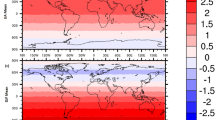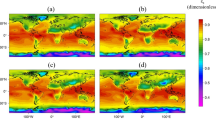Abstract
In the present study, we investigate the determination accuracy of the Universal Thermal Climate Index (UTCI). We study especially the UTCI uncertainties due to uncertainties in radiation fluxes, whose impacts on UTCI are evaluated via the mean radiant temperature (Tmrt). We assume “normal conditions”, which means that usual meteorological information and data are available but no special additional measurements. First, the uncertainty arising only from the measurement uncertainties of the meteorological data is determined. Here, simulations show that uncertainties between 0.4 and 2 K due to the uncertainty of just one of the meteorological input parameters may be expected. We then analyse the determination accuracy when not all radiation data are available and modelling of the missing data is required. Since radiative transfer models require a lot of information that is usually not available, we concentrate only on the determination accuracy achievable with empirical models. The simulations show that uncertainties in the calculation of the diffuse irradiance may lead to Tmrt uncertainties of up to ±2.9 K. If long-wave radiation is missing, we may expect an uncertainty of ±2 K. If modelling of diffuse radiation and of longwave radiation is used for the calculation of Tmrt, we may then expect a determination uncertainty of ±3 K. If all radiative fluxes are modelled based on synoptic observation, the uncertainty in Tmrt is ±5.9 K. Because Tmrt is only one of the four input data required in the calculation of UTCI, the uncertainty in UTCI due to the uncertainty in radiation fluxes is less than ±2 K. The UTCI uncertainties due to uncertainties of the four meteorological input values are not larger than the 6 K reference intervals of the UTCI scale, which means that UTCI may only be wrong by one UTCI scale. This uncertainty may, however, be critical at the two temperature extremes, i.e. under extreme hot or extreme cold conditions.






Similar content being viewed by others
References
ASHRAE (2001) ASHRAE Handbook: Fundamentals, 8. American Society of Heating and Air-Conditioning Engineers, Atlanta, GA
Badescu V (1997) Verificaton of some very simple clear and cloudy sky models to evaluate global solar irradiance. Sol Energy 61:251–264
Blazejczyk K (1997) Modèle statistique de la fraction du rayonnement solaire diffus à partir de différents types de nébulosité. Publication de l’Association Internationale de Climatologie, Vol 10, pp 119–125
Boland J, Ridley B, Brown B (2008) Models of diffuse solar radiation. Renew Energy 33(4):575–584. doi:10.1016/j.renene.2007.04.012
Brutsaert W (1975) On a derivable formula for long-wave radiation from clear skies. Water Resour Res 11:742–744
Choi M, Jacobs JM, Kustas W (2008) Assessment of clear and cloudy sky parametrizations for daily downwelling longwave radiation over different land surfaces in Florida, USA. Geophys Res Lett 35:L20402. doi:10.1029/2008GL035731
Crawford TM, Duchon CE (1999) An improved parameterization for estimating effective atmospheric emissivity for use in calculating daytime downwelling longwave radiation. J Appl Meteorol 38:474–480
Dahlback A, Stamnes K (1991) A new spherical model for computing the radiation field available for photolysis and heating at twilight, Planet. Space Sci 39:671–683
Deardorff JW (1978) Efficient prediction of ground surface temperature and moisture, with an inclusion of a layer of vegetation. J Geophys Res 83:1889–1903
Dilley AC, O’Brien DM (1998) Estimating downward clear sky long-wave irradiance at the surface from screen temperature and precipitable water. Q J R Meteorol Soc 124:1391–1401
Duarte HF, Dias NL, Maggioto SR (2006) Assessing daytime downward longwave radiation estimates for clear and cloudy skies in southern Brazil. Agric For Meteorol 139:171–181
Fanger PO (1970) Thermal Comfort. Danish Technical Press, Copenhagen, Analysis and Application in Environment Engineering
Fiala D, Lomas KJ, Stohrer M (1999) A computer model of human thermoregulation for a wide range of environmental conditions: The passive system. J Appl Physiol 87(5):1957–1972
Fiala D, Lomas KJ, Stohrer M (2001) Computer prediction of human thermoregulatory and temperature responses to a wide range of environmental conditions. Int J Biometeorol 45:143–159
Fiala D, Lomas KJ, Stohrer M (2003) First principles modelling of thermal sensation responses in steady state and transient boundary conditions. ASHRAE Trans 109(1):179–186
Fiala D, Bunzl A, Lomas KJ, Cropper PC, Schlenz D (2004) A new simulation system for predicting human thermal and perceptual responses in vehicles. In: D. Schlenz (ed). PKW-Klimatisierung III: Klimakonzepte, Regelungsstrategien und Entwicklungsmethoden. Haus der Technik Fachbuch Band 27, Expert, Renningen, pp. 147-162
Gopinathan KKA, Soler A (1995) Diffuse radiation models and monthly average, daily diffuse data for a wide latitude range. Energy 20:657–667
Gryning S, Batchvarova E, De Bruin HAR (2001) Energy balance of a sparse coniferous high-latitude forest under winter conditions. Bound Lay Meteorol 99:465–488
Gueymard CA, Myers DR (2009) Evaluation of conventional and high-performance routine solar radiation measurements for improved solar resource, climatological trends, and radiative modelling. Sol Energy 83(2):171–185
Gueymard CA, Myers DR (2008) Validation and ranking methodologies for solar radiation models. In: Badescu V (ed) Modeling solar radiation at the earth’s surface. Recent advances. Springer, Heidelberg
Halthore RN, Crisp D, Schwartz SE, Anderson GP, Berk A, Bonnel B, Boucher O, Chang F, Chou M, Clothiaux EE, Dubuisson P, Fomin B, Fouquart Y, Freidenreich S, Gautier C, Kato S, Laszlo I, Li Z, Mather JH, Plana-Fattori A, Ramaswamy V, Ricchiazzi P, Shiren Y, Trishchenko A, Wiscombe W (2005) Intercomparison of shortwave radiative transfer codes and measurements. J Geophys Res, 110, doi:1029/2004JD005293
Havenith G (2001) Human surface to mass ratio and body core temperature in exercise heat stress - a concept revisited. J Therm Biol 26(4–5):387–393
Höppe P (1999) The physiological equivalent temperature – a universal index for the biometeorological assessment of the thermal environment. Int J Biometeorol 43:71–75
Huizenga C, Hui Z, Arens E (2001) A model of human physiology and comfort for assessing complex thermal environments. Build Environ 36(6):691–699
Ineichen P (2006) Comparison of eight broadband models against 16 independent data banks. Sol Energy 80:468–478
Jacovides CP, Tymvios FS, Assimakopoulos VD, Kaltsounides NA (2006) Comparative study of various correlations in estimating hourly diffuse fraction of global solar radiation. Renew Energy 31:2492–2504
Jendritzky G, Nübler W (1981) A Model Analysing the Urban Thermal Environment in Physiologically Significant Terms. Arch Meteorol Geophys Biokl B 29(4):313–326
Jendritzky G, Sönning W, Swantes HJ (1979) Ein objektives Bewertungsverfahren zur Beschreibung des thermischen Milieus in der Stadt- und Landschaftsplanung ("Klima-Michel-Modell"). Beitr. Akad. f. Raumforschung u. Landesplanung 28, 85 S
Jendritzky G, Schirmer H, Menz G, Schmidt-Kessen W (1990) Methode zur raumbezogenen Bewertung der thermischen Komponente im Bioklima des Menschen (Fortgeschriebenes Klima-Michel-Modell). Akad Raumforschung Landesplanung, Hannover, Beiträge 114, ISSN 0935-0772
Jendritzky G, Maarouf A, Fiala D, Staiger H (2002) An update on the development of a Universal Thermal Climate Index. 15th Conf Biometeorol Aerobiol and 16th ICB02, 27 Oct – 1 Nov 2002, Kansas City, AMS, 129-133
Kasten F, Young AT (1989) Revised optical air mass tables and approximation formula. Appl Opt 28:4735–4738
Kasten F (1996) The Linke turbidity factor based on improved values of the integral Rayleigh optical thickness. Sol Energy 56:239–244
Konz S, Hwang C, Dhiman B, Duncan J, Masud A (1977) An experimental validation of mathematical simulation of human thermoregulation. Comput Biol Med 7:71–82
Konzelmann T, van der Wal RSW, Feuell W, Bintanja R, Henneken EAC, Abe-Ouchi A (1994) Parameterization of global and longwave incoming radiation for the Greenland ice sheet. Glob Planet Change 9:143–164
Long CN, Turner DD (2008) A method for continuous estimation of clear-sky down-welling longwave radiatiave flux developed using ARM surface measurements. J Geophys Res 113:D18206. doi:101029/2008JD009936
Martin M, Berdahl P (1984) Characteristics of infrared sky radiation in the United States. Sol Energy 33:321–336
Marty C, Philipona R, Delamere J, Dutton EG, Michalsky J, Stamnes K, Storvold R, Stoffel T, Clough SA, Mlawer EJ (2003) Downward longwave irradiance uncertainty under arctic atmospheres: measurements and modeling. J Geophys Res 108(D12):4358
Matzarakis A, Rutz F, Mayer H (2009) Modelling radiation fluxes in simple and complex environments: basics of the RayMan model. Int J Biometeorol. doi:10.1007/s00484-009-0261-0
Maykut GA, Church P (1973) Radiation climate of Barrow, Alaska. J Appl Meteorol 12:620–628
Niemelä S, Raisanen P, Savijarvi H (2001) Comparison of surface radiative flux parameterizations, part I: long-wave radiation. Atmos Res 58:1–18
Michalsky J et al (1999) Optimal measurement of surface shortwave irradiance using current instrumentation. J Atmos Ocean Technol 16:55–69
Prata AJ (1996) A new long-wave formula for estimating downward clear-sky radiation at the surface. Q J R Meteorol Soc 122:1127–1151
Reda I, Hickey JR, Stoffel T, Myers D (2002) Pyrgeometer calibration at the National Renewable Energy Laboratory (NREL). J Atmos Sol Terr Phys 64(15):1623–1629
Remund J, Wald L, Lefevre M, Ranchin T (2003) Worldwide Linke Turbidity Information. Proceedings of ISES Solar World Congress, 16–19 June 2003, Göteborg, Sweden, CD-ROM published by the International Solar Energy Society
Richards M, Fiala D (2004) Modelling fire-fighter responses to exercise and asymmetric IR-radiation using a dynamic multi-mode model of human physiology and results from the Sweating Agile thermal Manikin (SAM). Eur J Appl Physiol 92(6):649–653
Rigollier C, Bauer O, Wald L (2000) On the Clear Sky Model of the ESRA - European Solar Radiation Atlas - With Respect to the HELIOSAT Method. Sol Energy 68:33–48
Scharmer K, Greif J (ed.) (2000) The European Solar Radiation Atlas, Vol. 2: Database, Models and Exploitation Software, École des Mines de Paris, 1-296, France
Schmetz P, Schmetz J, Raschke E (1986) Estimation of daytime downward longwave radiation at the surface from satellite and grid point data. Theor Appl Climatol 37:136–149
Skartveit A, Olseth JA, Czeplak G, Rommel M (1996) On the estimation of atmospheric radiation from surface meteorological data. Sol Energy 56:349–359
Skartveit A, Olseth JA, Tuft ME (1998) An hourly diffuse fraction model with correction for variability and surface albedo. Sol Energy 63:173–183
Stolwijk JAJ (1971) A mathematical model of physiological temperature regulation in man. NASA contractor report, NASA CR-1855, Washington DC
Swinbank WC (1963) Long-wave radiation from clear skies. Q J R Meteorol Soc 89:339–348
Taylor KE (2001) Summarizing multiple aspects of model performance in a single diagram. J Geophys Res 106(D7):7183–7192
Tanabe SI, Kobayashi K, Nakano J, Ozeki Y, Konishi M (2002) Evaluation of thermal comfort using combined multi-node thermoregulation (65MN) and radiation models and computational fluid dynamics (CFD). Energy Build 34:637–646
VDI (1994) VDI guideline 3789 / part 2, Environmental Meteorology, Interactions between Atmosphere and Surfaces. Calculation of Short- and Long-wave Radiation. VDI-Handbuch, Reinhaltung der Luft Band 1, Beuth, Berlin
VDI (2008) VDI Guideline 3787 / Part 2: Environmental meteorology: Methods for the human biometeorological evaluation of climate and air quality for urban and regional planning at regional level. Part I: Climate. VDI/DIN-Handbuch Reinhaltung der Luft, Band 1 B, Umweltmeteorologie, Beuth, Berlin.
Weihs P, Webb AR (1997) Accuracy of spectral UV model calculations - 2. Comparison of UV calculations with measurements. J Geophys Res 102, No. D1.
Wild M, Long CN, Ohmura A (2006) Evaluation of clear-sky solar fluxes in GCMs participating in AMIP and IPCC-AR4 from a surface perspective. J Geophys Res 111:D01104. doi:10.1029/2005JD006118
Wissler EH (1985) Mathematical simulation of human thermal behaviour using whole body models. In: Shitzer A, Eberhart RC (eds) Heat transfer in medicine and biology - analysis and applications. Plenum, New York, pp 325–373
WMO (2003) Manual on the Global Observing System. Volume 1. Global aspects. World Meteorological Organisation No. 544 – Geneva
WMO (2008) WMO guide to meteorological instruments and methods of observation. World Meteorological Organisation No. 8 – Geneva
Ackowledgements
This work was initiated within COST action 730: “Towards a Universal Thermal Climate Index UTCI for Assessing the Thermal Environment of the Human Being”. Through discussions at meetings throughout the years, all participants in COST730 have contributed to this study.
Author information
Authors and Affiliations
Corresponding author
Rights and permissions
About this article
Cite this article
Weihs, P., Staiger, H., Tinz, B. et al. The uncertainty of UTCI due to uncertainties in the determination of radiation fluxes derived from measured and observed meteorological data. Int J Biometeorol 56, 537–555 (2012). https://doi.org/10.1007/s00484-011-0416-7
Received:
Revised:
Accepted:
Published:
Issue Date:
DOI: https://doi.org/10.1007/s00484-011-0416-7




